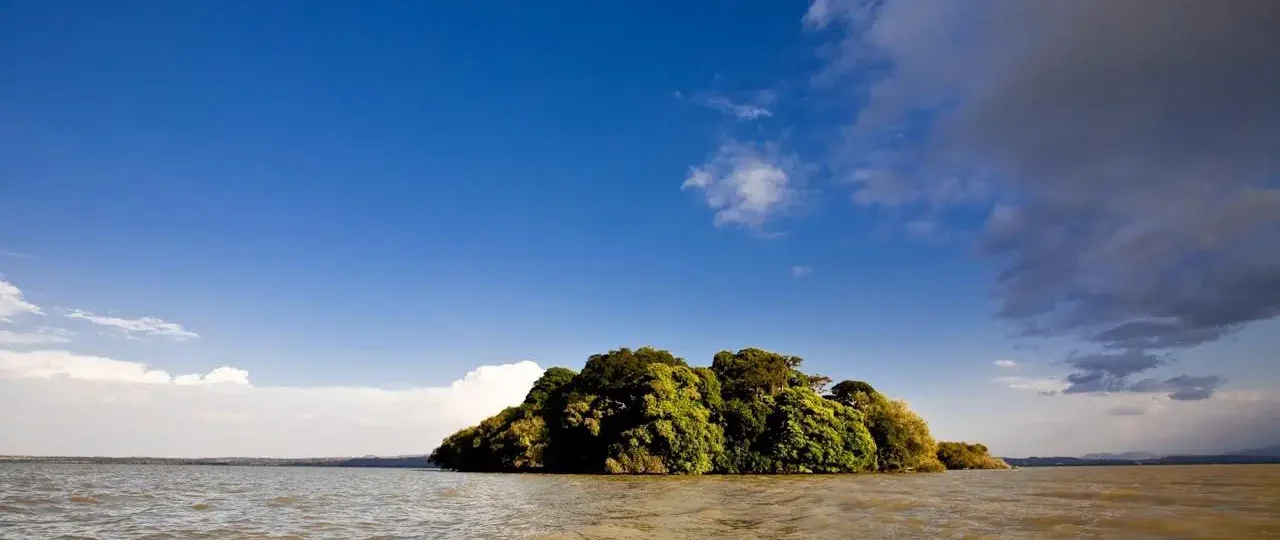Bahir Dar and Lake Tana
Bahir Dar, an attractive town, founded during the first decades of the 20thc, well lay out with palm lined avenues and with the blue of the lake in the background.
Lake Tana, a principal reservoir of the Nile, was known by the ancient Greeks as “copper tinted Lake” or “the Jewel of Ethiopia”, it is the largest lake, dotted with not less than 30 islands, on many of, which are found churches, unique monasteries and spectacular bird’s life. It had been serving as a link between Ethiopia and the ancient world. This spot is accessed by boats from the city. Here one could enjoy exploring church of St. Marry (monastery of Debra- Maryam), Hippos and the exact site where the famous Blue Nile River pours out of the lake. The most frequently visited place on Lake Tana is the Zegie peninsula, 20 kilometers, covered by a dense tropical forest. Walking through the forest topped by birds and monkeys and bathed by the fragrance of strange flowers leads to the reverend monasteries in the nearby.
Tana Chirkos
Tana Chirkos, the oldest monastery in Ethiopia, is situated to the eastern shore of the lake where one can observe life and rituals that have hardly been changed since the Old Testament. Tradition has it that the Ark of the Covenant was kept here for 800 years before it was removed to Aksum in the 4thc A.D by king Ezana.
This claim to antiquity is backed up by the presence of three hollowed out pillars, which, according to religious fathers of the monastery, were once used as Jewish sacrificial altars.
Tana Chirkos has the richest historical collections including the bowl (gomor), a vessel for blood sacrifice, bed and blankets of Gonderine kings, astonishingly big parchments including the one that was written by St. Yared in the 6thc.
This beautiful and unusual island is a sanctuary of birds of different species like humming birds, kingfishers, bright blue starlings and many others. Here, equally important is the monastery of kirstos Semera which, unlike Tana chirkos, is allowed for women.
Daga Estephanos
The monastery of Daga Estephanose that was built during the 13thc and one of the holiest places lies some 35 kilometers from Bahir Dar.The real historic interest in Daga lies in its treasury. Here together with numerous piles of brightly colored ceremonial robes are the glass coffins containing the mummified remains of several of the former emperors of Ethiopia; namely Yikuno Amlak, Dawit, Zera yakob, Ze Dingle and Atse Fasiladas who ruled from the 13th_ 17th centuries. Personal possessions of these emperors are also kept in the storehouse. Daga is closed for women.
Narga Sillassie
The Monastery of Narga found 35 kilometers away from Bahir Dar was founded by Empress Mintwab in the 18thc.Its architectural style has direct resemblance to the building of Gondar. The doors carved from single log are interesting. Inside the wall is decorated with vivid religious paintings showing scenes of the life and crucifixion of Christ, the miracles and flight of Mary and the struggle of Martyrs.
Narga also houses treasuries of the Gonderian period. When you are not in shortage of time, explore the neighboring monasteries and the life of the local community. Camping among this isolated communities and making a luxurious cruise to Gondar via Gorgora will be a historic event in life.
Kibran Gebriel
Founded during the reign of Amde Tsion in the 14thc and rebuilt by Iyasu I in the 17thc, the monastery of Kibran has a distinct cathedral atmosphere. Mural paintings and an iron cloth of the founding saint, illuminated manuscripts and other invaluable antiques make the monastery worth visiting. Kibran is allowed only for men.
Lake Tana Monasteries
Women & Men can visit
- Debre Mariam: southern, the temple is reputedly very ancient have three ancient Ge’ez goat skin manuscripts.
- Ura Kidane Mehiret: southern, the most impressive and frequently visited monastery, founded in 14th century re built in 16th century; the walls are covered in incredible jumble of 16th century murals.
- Azuwa Mariam: southern, near to Ura Kidane Mehiret, boasts several animated 18th century paintings,
- Bete Mariam &Mehal Giyorgis: southern, near Azuwa Mariam, boasts several animated 18th century paintings
- Entos Mariam: south of Kibran
- Narga Sellassie: central, the inner walls are covered from top to bottom with a riotous and absorbing collection of paintings, most thought to date back to the 18th century, there is a painting of Mary and baby Jesus, probably the only contemporaneous portrait of Mentewab to Servive.
- Mandaba Medhane Alem, northern to the way to Gorgora, 14th century, known for its collections of old manuscripts, paintings, and antiquated treasures.
- Birgda Mariam, northern 14th century, hosted 16th century painting of Saint Mary,Angara Tekle Haimanot, Bahir Galila Zacharias, northern the oldest of all, the 14th century.
Men Only:
- Kibran Gebriel: southern 30min by boat from Bahirdar, houses the largest library of ancient books including 15th century life of Christ. Not assessable for women.
- Dega IStafanos: central, founded in late 13th century,the mausoleum, contains the mummified remains of at least five Ethiopian Emperors, Yekuno Amelak, Dawit I, Zere Yakob, Susneyos and Fasiledas.
- Tana Chirkos: central, the Ark of the Covenant was stowed on the Island for some 800years before it was transferred to Axum in 4th century AD by king Ezana.
Crossing up to Gorgora
Monastery of Debre Sina Mariam, The Ethiopian Orthodox Church is a pioneer to modern education in the country. Still today there are famous traditional schools in Bahir Dar where prospective clergies learn Geez, and hymn, writing on parchment. The system of education and the living styles of students in their small huts are amazing. Hence, get them closely attached to the different churches of the town.

